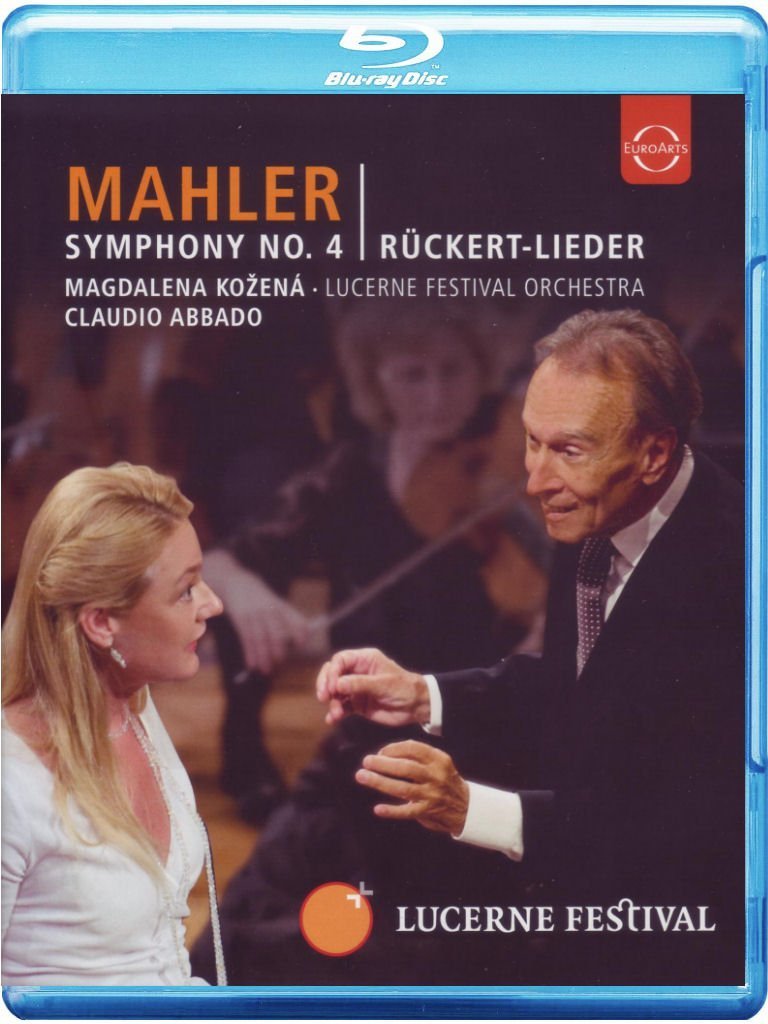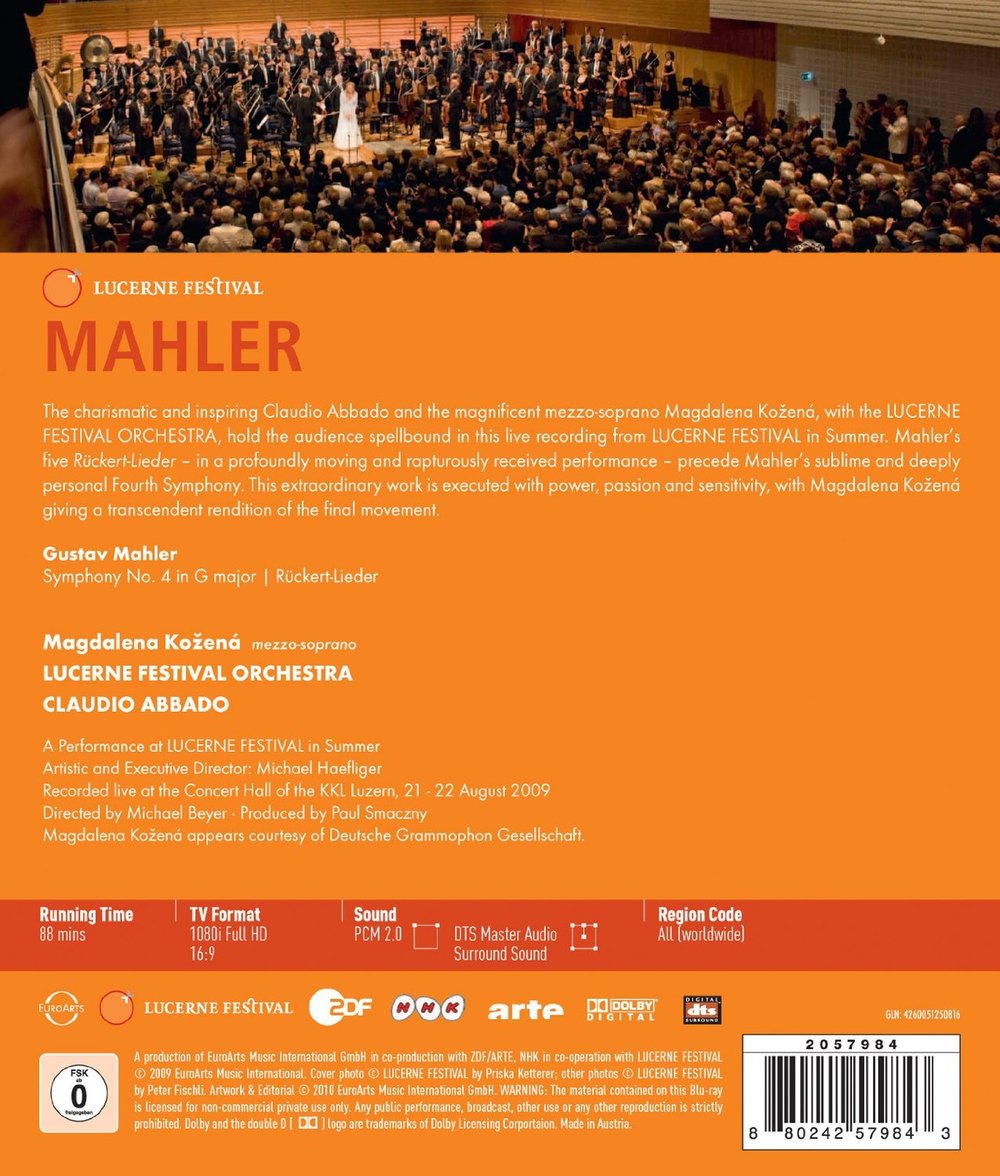

Mahler Symphony No. 4 and Rückert-Lieder concert. Claudio Abbado conducts the Lucerne Festival Orchestra in 2009 with mezzo-soprano Magdalena Kožená. Directed for TV by Michael Beyer. Released 2010, disc has 5.1 dts-HD Master Audio sound. Grade: C+ for Mahler Symphony No. 4 and Grade: B+ for the Rückert-Lieder
(At the concert and on the disc, the Lieder come first as a warm up, but we will report on the symphony first.)
Symphony No. 4, a relatively short, blissful work in contrast to the previous Mahler gigantics, provides some Weltschmertz analgesic. Gramophone in February 2011 gave this recording a glowing review, but you can't tell if the reviewer watched the DVD or Blu-ray version. Nigel Simeone writing in the International Record Review said "This is a DVD to cherish." (He apparently didn't know the title is available in Blu-ray.) These comments from the print critics suggest that the performance was excellent. But the Blu-ray video doesn't match the glowing performance reviews. At the beginning of the symphony, the SQ is shaky with muddiness and a harsh bass. In an early harp solo, I couldn't hear the instrument at all. But the SQ does improve as the music unfolds, although the sound is never as good as we experience on the NHK discs we prize. But the worse problems are weak PQ and video content with a numbing case of DVDitis. In the first screenshot below, a whole-orchestra view at the opening of the symphony, we note a distinct softness in video resolution:
In the part-orchestra shot below we can make out more details:
There are 503 video clips in this 56-minute symphony recording. 271 clips show solos or small groups. My favorite solo shot is the sole harp player. We see her hands and the harp strings often, so I was happy to finally see her in this beautiful image
There are only 14 large-section shots in the symphony video. The best of these, and the only shot of all the cellos, is the angle next below:
And next is a decent shot of a large group of violins:
And also a neat shot of a large group of winds:
At this point, you've already seen the best of the best. The video is plagued with many errors and unhappy views. The next two shots have frame and focus errors with only one player in each shot in focus. In small groups like these, everything should be in perfect focus throughout the depth of the field shown:
I complain on this website about wasteful shots of the conductor over the backs of musicians. The next view below is not one of the dreaded "shot-over-backs" that I hate. True, there are some backs and the conductor in view. But I note the elevation of the camera is high enough to make this into a shot of all 16 of the violas. Lower the camera a foot or so and all you have is a mess with the conductor hovering above it:
Next below is a bad conductor-over-backs view:
The one next below is really rotten:
There are 39 conductor-over-backs in this video, and the shot below is included in that count. Maybe I should call this an "audience" shot:
Magdalena Kožená slips onstage during the break before Movement 3. She will rise at Movement 4 which starts without a break after M3:
Now Magdalena is up to sing, and the TV director gives us a shot of her backside! Is this a nice way to treat a lady and star opera singer?
Movement 4 is short and dominated by the soprano. Magdalena is a natural face-maker on stage:
At the end you see how beautiful she really is:
Now, alas, we must have another talk about the dread disease of DVDitis (see our special article for full information about this malady). This symphony video has 503 clips over 3387 seconds of music, for an average clip length of 6.7 seconds. This is a DVD-like pace that's too fast for a good HDVD. There are 14 large section or group shots, 8 part-orchestra shots, and 12 whole-orchestra shots. If we add to these "supershots" the 22 soloist clips, the total is 56 supers. This is 11% of the total clips, a number that is only half of the minimum percentage of supershots that an HDVD should have. And 28% of all the clips are of the conductor, another hallmark of DVDs. The evidence is overwhelming: this video contains DVD content that has been prettified with HD resolution (sort of) and better sound (sort of). This video has "DVD" tattooed in scarlet on its brow.
Time for a grade: Start with A+. For soft resolution and odd color balance, reduce to B. For rigor mortis-level DVDitis I reduce to D. But for an excellent performance and nice sound (after a rough start), I will move back up to C+for our grade. Let's try to be fair: The print experts praised this performance and record. Maybe this is as good or better as anything you can buy in LP or CD, and even a mediocre video is a nice jump for the good over just listening. But this website is not about comparing mediocre fare to legacy recordings. We want great and a video that takes full advantage of HD TV. We challenge the industry to give us this rather than warmed-over SD.
Now let's consider the 5 short Rückert-Lieder. When you first see Magdalena Kožená, you might be startled by her exaggerated facial expressions. You'll get over it as you listen to her warm and intelligent singing, which the Lucerne audience clearly loved. Mahler provides an elaborate orchestral accompaniment for these simple songs, so one doesn't get to hear this often. The orchestral part features atmospheric solos by virtuoso instrumentalists, so the video content for this music would be the same in DVD or HDVD.
Here's a whole-orchestra view of the Rückert-Lieder segment (really an architectural view) followed by 3 shots of the soloist:
With all the orchestral colors created by Mahler, there are great photo ops. Here's a rare shot of the contra-bassoon:
Two harps get plenty of action:
And who could resists this "instrument-valves-only" shot of the tuba player:
If Sir Rattle loved this, why shouldn't I?
I'll grade the Rückert-Lieder segment as B+.
OR
























